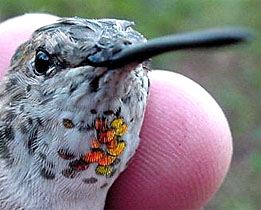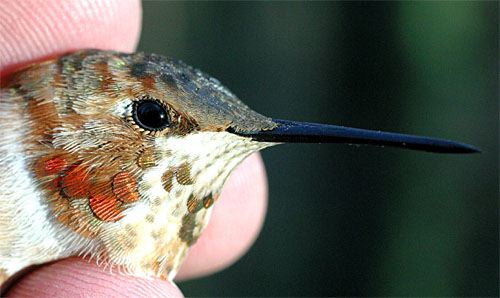|
|
|||
|
All text & photos © Hilton Pond Center #Y14795 at first capture (left, 14 Mar 2002) and first recapture (29 Nov 2003), both at Tryon NC During Thanksgiving Week 2003, while examining a list of vagrant hummingbirds we've banded in the Carolinas since 1991, we wondered how many folks whose yards we visited in the past might have wandering hummers again this year. We decided to contact those homeowners via E-mail, but Alan Peoples of Tryon NC (Polk County) beat us to the punch with a phone call on the afternoon of 26 November. We had met with Alan and his wife Harriet--a cousin and former high school classmate of ours--on 14 March 2002 when we banded a female Rufous Hummingbird partaking of their feeder. With understandable excitement, Alan called this year to say another hummer that had been stopping in sporadically for a few weeks was coming regularly to the feeder and that we were welcome to come to Tryon for a banding expedition. Since we were to be in nearby Greenville SC on 28 November for post-Thanksgiving family events, we planned to make the one-hour trip up I-26 the following day. We also asked Alan to send us the directions to his house so we wouldn't get lost in pre-dawn darkness when we came up. Alan responded within the hour but preceded his directions with a titillating line: "As I am writing this, Harriet just called up to say that there is a second hummie chasing the first," and that it looked a little browner.
Having thought about all this on Thanksgiving and the day following, we had no trouble getting up on 29 November for the drive to Tryon--even though the temperature was well below freezing. We arrived at 6:30 a.m. and had our portable trap hung--complete with the Peoples' feeder inside as bait--by 6:45 a.m., after which we were happy to join Cousin Harriet inside for a cup of hot tea. We got caught up on the latest news as we waited for the sun to peek over the mountains to our east. At precisely 7 a.m., a hummingbird flew up to the trap, looked at it hard, spent several minutes trying to get at the feeder through the wire mesh, and then perched on the back of the trap and cocked its head from side to side. The bird then departed quickly, only to return at 7:05 a.m. and perch on the front sill of the entry door of the trap. From this vantage point it had an unimpeded view of the feeder, but the bird seemed none to eager to eat. Finally, at 7:10 a.m. it flew 12 inches to the feeder perch and began drinking, after which we hit our remote button that let the trapdoor slide shut.
We went back out into the cold and gently removed the hummer from the trap. In hand we checked its legs and, sure enough, there was a tiny aluminum band on the right one: #Y14795, our old friend from March 2002. Curiously, Harriet and Alan didn't observe this bird the fall or winter of 2002, but here it was back again on Thanksgiving 2003, perhaps with a strange tale to share if only we could understand "hummingbirdese." The hummer looked a little different than she did 20 months ago (top two photos), with a few more metallic orange-red gorget feathers and much smoother overall appearance (see two photos immediately above); in other words, had the plumage of the mature adult that she had become. It was interesting that, despite having gone through several molts, her measurements were essentially the same as in 2002, with only a slight increase in wing chord length (see table below).
After photographing #Y14795, we inserted her bill into the feeder hanging in the trap and watched her lap up sugar water, and eventually bid her fond adieu as she flew straight down the hillside and out of sight. Making sure the trap was re-set, we went back inside at about 7:40 a.m. for more conversation with Harriet and another cup of hot tea, ever hopeful that a second bird might put in an appearance sometime soon.
Relatively speaking, we didn't have a long wait, for at 8:20 a.m. a hummer flew straight to the trap and entered, but it chose to perch on the far side of the one-quart feeder--just where we couldn't see it. Eager to catch the bird but not wanting to disturb its feeding if it was #Y14795 coming back for a re-fill, we exercised extreme restraint and let the bird feed for about 20 seconds before hitting the remote release. Even after the door slid shut behind it the bird continued to feed, and it wasn't until we exited the house and approached the trap that the hummer tried to escape.
It was immediately obvious that the current capture was a new bird; the rusty color at the bases of its tail feathers and on its rump stood out brilliantly even in the early morning light, and Harriet's original observation that it "looked a little browner" was borne out. What we had here was a young male Selasphorus hummingbird, either another Rufous (S. rufus) or an Allen's (S. sasin).
Taking the bird inside, we made our usual measurements (below) and determined it was too big for an Allen's, so hatch-year male Rufous it was. This bird, like the female we had re-trapped earlier that day, was undoubtedly hatched out in southern Alaska, western Canada, or the northwestern U.S. and would be expected to be in warm and sunny central Mexico at this time of year.
This young male was missing its four outermost tail feathers on the right--and those that remained showed a lot of wear--but the presence of partial rusty back plumage and 13 orange-red metallic throat feathers indicated this may have been due at least in part to the molt it would normally be expected to undergo between now and next spring. After this latest banding in Tryon, Alan Peoples has an interesting tale to share with his high school civics and journalism students, and maybe even with the Tryon town council that he leads as mayor. He and Harriet are now in a VERY select group of winter vagrant hummingbird hosts in that they've had birds in more than one year, had both male and female Rufous, had two birds at one time, AND had a bird that returned in at least one later winter after it was banded. We can't WAIT to see what else might come to the Peoples house as this and later winters unfold. Vital Statistics for All text & photos © Hilton Pond Center
If you're interested in sharing your hummingbird observations and learning from other enthusiasts, you may wish to subscribe to Hummingbird Hobnob, our Yahoo!-based discussion group. Also be sure to visit our award-winning Web site for Operation RubyThroat: The Hummingbird Project; on it you'll find almost anything you want to know about hummingbirds, including more information about Hummingbird Banding.
For much more information about hummingbirds, visit Operation RubyThroat: The Hummingbird Project  |
|
Make direct donations on-line through
Network for Good: |
|
|
LIKE TO SHOP ON-LINE?
Donate a portion of your purchase price from 500+ top on-line stores via iGive: |
|
|
Use your PayPal account
to make direct donations: |
|









 By then its back and head will be all rusty and the gorget will be completely iridescent, a gradual change Harriet and Alan will be able to observe if the bird hangs around all winter.
By then its back and head will be all rusty and the gorget will be completely iridescent, a gradual change Harriet and Alan will be able to observe if the bird hangs around all winter.
 Students at GLOBE-certified schools may submit winter hummingbird observations as part of Operation RubyThroat and GLOBE. Students can also correlate hummingbird observations with data on abiotic factors, including atmosphere, climate, hydrology, soils, land cover, and phenology. See the
Students at GLOBE-certified schools may submit winter hummingbird observations as part of Operation RubyThroat and GLOBE. Students can also correlate hummingbird observations with data on abiotic factors, including atmosphere, climate, hydrology, soils, land cover, and phenology. See the 


